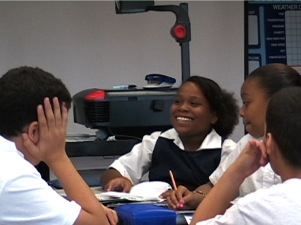
knowing and doing science in an urban environment
Minority girls, identity, and learning
The past 15 years have given birth to a wealth of research around girls’ achievement in and motivations for participating in science . This research has provided a detailed portrait of the barriers girls face in their quest to achieve and to express interest in middle school science, and of the kinds of programs that best support girls in overcoming these barriers. The barriers that girls face in engaging with and succeeding in school science range from school and societal attitudes that portray science as masculine and girls as incapable of meeting its challenges to the lack of equity-minded curricula, pedagogical strategies, and professional development tools available to teachers and staff developers.

Research is needed that moves beyond girls as a homogenous population. The issues which frame learning and access in science vary across different populations of girls (Hammrich, 2001). For example, research in urban science education shows that girls living in high-poverty urban communities face unique barriers to equitable science education, which include curricular and pedagogical practices driven by high stakes exams in mathematics and literacy, often leaving little time for science instruction (Tate, 2001), lack access to rigorous and high-level science courses, science equipment, appropriate role models, and certified, qualified teachers (Oakes, 1990, 2000), and fewer opportunities to participate in science programs that value the discursive practices and embodied experience they bring to science learning (Brickhouse & Potter, 2001; Calabrese Barton, 1998). Thus, it is understandable that urban girls overwhelmingly choose not to see themselves as scientists or as scientific.
A focus on girls’ identities, particularly on how and why they draw on particular Discourses when interacting with science, is essential to understanding how girls engage in science because it allows for important  connections to be made between the contexts of girls’ lives and how and why they do science. Girls’ identities may change depending on the context within which they are doing science, depending on who they are with, where they are, and what is motivating them to engage in a certain practice at a particular moment.
connections to be made between the contexts of girls’ lives and how and why they do science. Girls’ identities may change depending on the context within which they are doing science, depending on who they are with, where they are, and what is motivating them to engage in a certain practice at a particular moment.
 connections to be made between the contexts of girls’ lives and how and why they do science. Girls’ identities may change depending on the context within which they are doing science, depending on who they are with, where they are, and what is motivating them to engage in a certain practice at a particular moment.
connections to be made between the contexts of girls’ lives and how and why they do science. Girls’ identities may change depending on the context within which they are doing science, depending on who they are with, where they are, and what is motivating them to engage in a certain practice at a particular moment. Discourses can also be drawn from youths’ various funds of knowledge (Moje, Collazo, Carrillo, & Marx, 2001). Nespor (1997) further argues for thinking about funds of knowledge as intersections of networks—family, peer and commercial networks. These intersections are valuable sites for identifying and accessing some of the Discourses that youth may draw upon in their science engagement.
Papers
1. Tan, E. & Calabrese Barton, A. (2006). From peripheral to central, the story of Melanie’s metamorphosis. A paper prepared for submission to Science Education. (download) (Videos)

